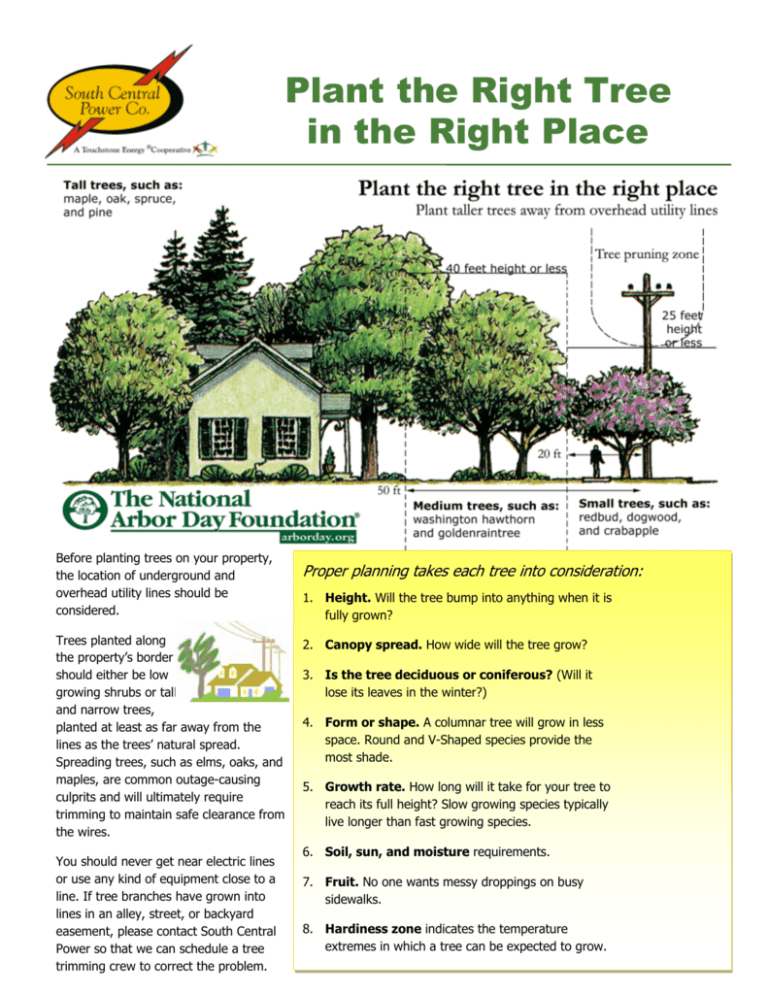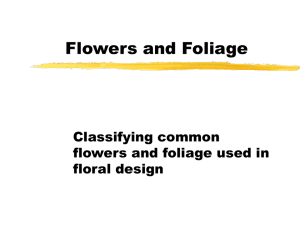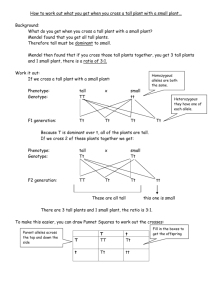Plant the Right Tree in the Right Place
advertisement

Plant the Right Tree in the Right Place Before planting trees on your property, the location of underground and overhead utility lines should be considered. Trees planted along the property’s border should either be low growing shrubs or tall and narrow trees, planted at least as far away from the lines as the trees’ natural spread. Spreading trees, such as elms, oaks, and maples, are common outage-causing culprits and will ultimately require trimming to maintain safe clearance from the wires. You should never get near electric lines or use any kind of equipment close to a line. If tree branches have grown into lines in an alley, street, or backyard easement, please contact South Central Power so that we can schedule a tree trimming crew to correct the problem. Proper planning takes each tree into consideration: 1. Height. Will the tree bump into anything when it is fully grown? 2. Canopy spread. How wide will the tree grow? 3. Is the tree deciduous or coniferous? (Will it lose its leaves in the winter?) 4. Form or shape. A columnar tree will grow in less space. Round and V-Shaped species provide the most shade. 5. Growth rate. How long will it take for your tree to reach its full height? Slow growing species typically live longer than fast growing species. 6. Soil, sun, and moisture requirements. 7. Fruit. No one wants messy droppings on busy sidewalks. 8. Hardiness zone indicates the temperature extremes in which a tree can be expected to grow. What trees should I plant? Below describes a number of different trees suitable for planting adjacent to overhead power lines. ‘Royal Burgundy’ Cherry (prunus serrulata ‘Royal Burgundy’): 20’ tall; 15’ wide; large clumps of pink, double fragrant blooms are framed by the deep purple leaves in spring; in fall the leaves retain their purple, and many turn red as the mobile pigments leave the move down the tree; susceptible to sun scald if stressed by drought, so irrigation should be scheduled during the dry season; zones 5-8; upright vase, oval form; moderate growth; sand, loam soils; pH: acidic, alkaline ‘Royal Burgundy’ Cherry ‘Snow Goose’ Cherry (prunus ‘Snow Goose’): 25’ tall; 20’ wide; foliage is green featuring showy white, early spring blooms; prefers moist soil, tolerates clay; zones 5-8; rounded, upright form ‘Snow Goose’ Cherry ‘Canada Red’ Chokecherry (amelanchier): pyramidal to oval-rounded form; 20-30’ tall; 15-20’ wide; white flowers produced with the leaves in spring; reddish-purple fruit in summer that attracts birds; full sun; adaptable to most soils and pH; needs well-drained soil; tolerant to drier soils; intolerant to poorly drained, compacted soil; sensitive to road salt ‘Canada Red’ Chokecherry ‘Kousa’ Dogwood (cornus kousa chinensis): 20-30’ tall; 20-30’ wide; widely adaptable soil; widely adaptable moisture; bushy form; moderate growth rate; white flowers in spring; turns red to maroon color in fall; dark green foliage in summer; zones 5-9 ‘Kousa’ Dogwood Japanese Tree Lilac (syringe reticulate): 20’ tall; 15’ wide; large creamy white flowers in June/July; oval-rounded to vase-shaped crown form; needs at least 6 hours of direct sunlight per day to produce flower buds; needs well-drained soil; medium growth rate; reddish-brown, cherry-like bark, and clean, dark green leaves; zones 3-7 Japanese Tree Lilac ‘Thundercloud’ Plum (prunus cerasifera ‘Thundercloud’): 20’ tall; 20’ wide; displays fragrant, single pink flowers that bloom in spring before foliage emerges; glossy, deep purple foliage throughout growing season; round vase shape form; prefers sandy or clay soils; widely adaptable moisture; medium growth rate; zones 5-8 ‘Thundercloud’ Plum Crabapple (malus): 18-20’ tall; 10-25’ wide; white or pink flowers; green color foliage; upright form; fast growth rate; adaptable to varying soils conditions; drought tolerant; zones 4-8 ‘Crabapple Redbud (cercis canadenis): 25’ tall; 30’ wide; pink blossoms in spring; leaves turn yellow color in fall; rapid growth rate; round mature form; does well in many types of soils; has low water requriements; zones 4-9 Eastern Redbud ‘Cockspur’ Hawthorn (crateaegus crus-galli): 20’ tall; 20’ wide; glossy dark green foliage, and showy flowers and fruit; widespreading plant form; 2-3” clusters of white flowers in spring; needs well-drained soil; fairly tolerant of drought; does best in full sun; bright red fruit produced in late summer and early fall; zones 4-7 ‘Cockspur’ Hawthorn ‘Winter King’ Hawthorn (crateaegus viridis ‘Winter King’): 20’ tall; 25’ wide; white flowers that form against green leaves; fruits heavily when young and retains fruit throughout winter; vase mature form; medium growth rate; turns reddishpurple in fall; does well in many types of soil; zones 4-7 ‘Winter King’ Hawthorn Serviceberry (amelanchier): 15-20’ tall; 18-25’ wide; white flowers in spring; green foliage color in summer; leaves turn a brilliant yellow, red or orange; widely adaptable soil types; widely adaptable moisture; irregular shrubby form; moderate growth rate; zones 4-7 Serviceberry Tips for landscaping around transformers People prefer underground electric lines in 2. their neighborhood. Pad-mounted transformers are part of the underground system. They are placed on easements in yards and serve the same purpose as transformers on utility poles. Because transformers may serve several homes, underground lines may go out from them in many directions. Maintain a 6-foot clearance to the sides and back of the transformer. Equipment inside the box generates heat and needs air circulation to keep cool and run efficiently. Overheating could cause an outage. 6 feet 1. Maintain a 10-foot clearance in front of the transformer. Equipment inside is energized at high voltage. Line crews work on “energized” transformers to avoid interrupting your service. The linemen use long fiberglass (insulating) sticks and need the clear space to work safely. FRONT OF TRANSFORMER 10 feet 3. Use gravel, wood chips, grass or low ground cover around the transformer. Flowers are okay but may get trampled if we have to work on it. Hiding Electric Lines and Poles Call Before You Dig • Poles cannot totally be hidden. • Use vegetation to draw your eyes away from poles. • Plant trees that have a spreading crown to diffuse the vertical view. Before your shovel hits the dirt, be sure all underground utility lines are marked. At least two working days before you start, call 1-800-362-2764 or 811 and OUPS (Ohio Utilities Protection Service) will notify South Central Power and other utilities and whether underground facilities are at the site. • Strategically plant trees in your yard to block the view of poles. Keep in mind that you have to look up to see the lines. • Plant lower-growing trees or shrubs near the base of poles, but no closer than 5 feet. • Do not plant vines that will grow up poles. Vines on poles may pose a threat to utility workers, when climbing poles. There is NO CHARGE to you for this service. It is your responsibility to know where electric fences, pet fences, etc. are located. When you get ready to plant, stay at least 24 inches away from any marked lines, and consider the length and depth of the roots of the mature tree. Find out about many other energy topics by visiting www.southcentralpower.com.








